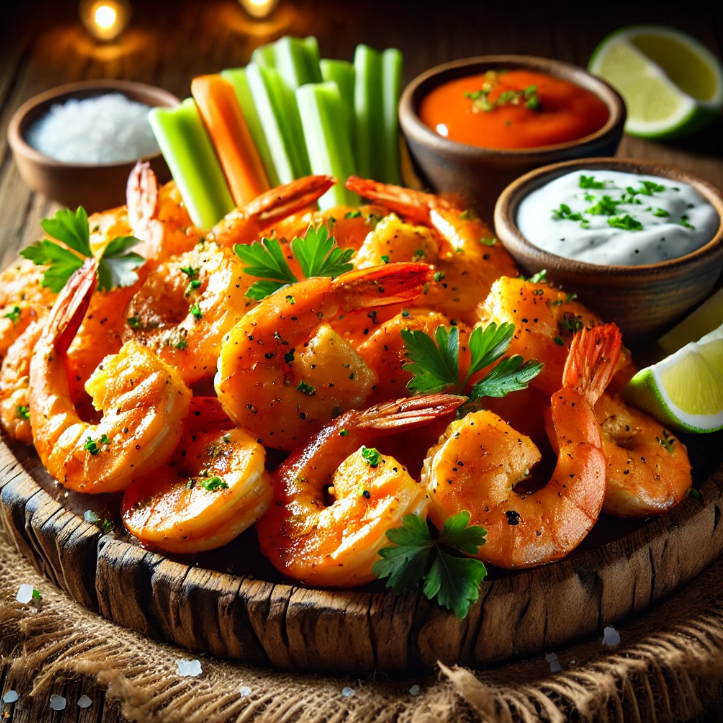Cooking shrimp can be a tricky endeavor. One moment they’re soft and juicy, and the next, they’re tough and rubbery. Whether you’re preparing shrimp for a salad, pasta, or stir-fry, achieving the perfect tenderness is key to elevating your dish.
In this guide, we’ll explore how to cook shrimp soft and tender by understanding the science behind shrimp texture, selecting the right shrimp, and mastering the best cooking techniques. By following these tips, you’ll impress your guests—and yourself—with perfectly cooked shrimp every time.
Table of Contents
Understanding the Basics of Cooking Shrimp
What Makes Shrimp Tough or Rubbery?
Shrimp is a delicate protein, and its texture can change dramatically with just a few seconds of overcooking. When shrimp are exposed to high heat for too long, their proteins contract excessively, leading to a rubbery texture. Similarly, cooking shrimp at uneven temperatures can leave you with an inconsistent bite—some soft, others tough.
Overcooking is the primary culprit when shrimp become rubbery, but it’s not the only factor. Using the wrong cooking method or failing to prep the shrimp properly can also affect the final texture.
The Science of Tender Shrimp
The secret to how to cook shrimp soft and tender lies in controlling the cooking process. Shrimp contain a natural protein called myosin, which firms up when heated. To keep shrimp tender, you need to strike the right balance between cooking it thoroughly and preserving its natural juiciness.
Low and slow methods, such as poaching or steaming, help retain moisture while gently cooking the shrimp. Quick-cooking techniques like sautéing are also great for locking in tenderness, as long as you don’t overdo it.
Temperature control and timing are critical. Shrimp are done when they turn pink and opaque, usually within just 2–3 minutes. Beyond this point, the texture starts to degrade, leaving you with a less-than-ideal dish.
Now that you understand the basics, let’s move on to selecting the right shrimp and preparing them for cooking.
Selecting the Right Shrimp
Fresh vs. Frozen Shrimp: What’s Better for Tenderness?
When it comes to how to cook shrimp soft and tender, the quality of your shrimp matters. Both fresh and frozen shrimp can yield great results, but each has its advantages.
- Fresh shrimp: If you have access to fresh shrimp, they often provide the best texture and flavor. However, freshness is key. Look for shrimp with a firm texture, a mild sea smell, and a shiny appearance.
- Frozen shrimp: Surprisingly, frozen shrimp are often fresher than those labeled “fresh” at the store. Shrimp are typically frozen right after being caught, locking in their natural tenderness. When buying frozen, choose shrimp labeled “individually quick frozen (IQF)” and avoid packages with frost or ice crystals, as these can indicate freezer burn.
Pre-Cooking Tips: Deveining and Cleaning
Properly preparing your shrimp before cooking is essential for achieving that soft, tender texture.
- Devein the shrimp. Remove the black vein along the back of the shrimp. While it’s not harmful, leaving it in can affect the shrimp’s taste and appearance.
- Remove the shell, if desired. Shells protect the shrimp during cooking, but peeling them beforehand can allow flavors to penetrate more effectively. For tenderness, consider leaving the tail on for added moisture.
- Dry the shrimp. Pat the shrimp dry with paper towels before cooking. Excess moisture can interfere with achieving a soft, consistent texture.
Techniques for Cooking Shrimp Soft and Tender
Poaching: A Gentle Cooking Method
Poaching is one of the best techniques for ensuring shrimp stay tender and juicy. It’s a low-heat, slow-cooking method that locks in moisture.
- Prepare the poaching liquid. Combine water, lemon slices, garlic, bay leaves, and a pinch of salt in a pot. Bring it to a gentle simmer.
- Add the shrimp. Lower the shrimp into the liquid and reduce the heat so it stays just below a boil.
- Cook until pink. Shrimp typically poach in 2–4 minutes. Remove them as soon as they turn opaque to avoid overcooking.
Sautéing for Quick and Juicy Results
If you’re short on time, sautéing is a great option for cooking shrimp soft and tender. This method is quick and ensures even cooking.
- Heat the pan. Use medium heat and add a little butter or olive oil.
- Cook the shrimp. Place the shrimp in the pan in a single layer. Cook for 1–2 minutes per side, flipping when they turn pink.
- Avoid overcrowding. Overcrowding the pan can cause uneven cooking.
Steaming: Locking in Moisture
Steaming is a foolproof method that keeps shrimp tender by surrounding them with gentle, moist heat.
- Prepare the steamer. Fill the bottom of a steamer pot with water, add aromatics, and bring it to a boil.
- Steam the shrimp. Place the shrimp in the steamer basket, cover, and steam for 3–5 minutes until pink and opaque.
- Check for doneness. Steaming minimizes the risk of overcooking, but keep an eye on the shrimp to ensure they don’t toughen.
By mastering these methods, you’ll confidently know how to cook shrimp soft and tender while enhancing their natural flavor and texture. Next, we’ll explore ways to boost flavor without compromising tenderness.
Flavor Boosters Without Compromising Tenderness
Marinades That Enhance Tenderness
Marinating shrimp before cooking is a simple yet effective way to ensure they turn out soft and tender. Acids like lemon juice or vinegar help break down the proteins in shrimp, making them juicier. However, it’s essential not to over-marinate as excessive acid exposure can toughen the meat.
For best results:
- Use a mixture of olive oil, lemon juice, garlic, and herbs.
- Let the shrimp sit in the marinade for no more than 20–30 minutes.
Additionally, dairy-based marinades such as yogurt or buttermilk can tenderize shrimp while adding a subtle creaminess to the flavor.
Adding Aromatics During Cooking
Aromatics like garlic, ginger, and fresh herbs infuse shrimp with flavor without overwhelming its delicate taste. Here’s how to do it:
- Add crushed garlic and sliced ginger to your poaching liquid or steaming water.
- Sprinkle fresh parsley or cilantro over the shrimp after cooking for a bright, herbaceous finish.
For bold flavors, experiment with spices like smoked paprika or crushed red pepper flakes, which complement the natural sweetness of shrimp.
(Explore this marry me chicken soup recipe for a unique twist on seafood and poultry.)
Avoiding Common Shrimp Cooking Mistakes
Overcooking: How to Tell When Shrimp is Done
Overcooking is the most common mistake when preparing shrimp. Cooked shrimp should be pink and opaque, with a slight curl. If the shrimp curls into a tight “C” shape, it’s overdone.
- Pro Tip: Keep a close eye on the shrimp while cooking, as they only take 2–4 minutes to finish. Using a kitchen timer can help prevent overcooking.
Avoiding Too Much Heat Too Quickly
High, direct heat can cause shrimp to toughen. While it’s tempting to crank up the stove for a quick sear, this can result in uneven cooking.
- Solution: Opt for medium heat when sautéing or grilling shrimp. Gradual heat ensures the shrimp cooks evenly without losing its tender texture.
By avoiding these common pitfalls, you’ll have a better chance of mastering how to cook shrimp soft and tender. The next section will address frequently asked questions to help you troubleshoot and refine your shrimp-cooking techniques.
(For more on seafood, try this Maine lobster roll recipe for a coastal delicacy.)
Frequently Asked Questions (FAQs)
Can You Tenderize Shrimp Before Cooking?
Absolutely! Tenderizing shrimp before cooking can make a noticeable difference in texture. One common method is brining, which involves soaking the shrimp in a mixture of water, salt, and sugar. Brining not only tenderizes the shrimp but also enhances its natural flavor.
- Pro Tip: Soak the shrimp in the brine for 15–20 minutes before rinsing thoroughly. This short process ensures they’re ready for cooking.
Alternatively, marinating shrimp in a yogurt-based mixture can also help break down proteins for extra softness.
How Long Should You Cook Shrimp for Best Results?
Shrimp cook quickly, typically within 2–4 minutes. Overcooking is the main reason shrimp lose their tender texture, so it’s crucial to monitor them closely.
- Key Indicator: Shrimp are done when they turn pink and opaque, with the tails forming a gentle curve. For precision, use a thermometer to check for an internal temperature of 120°F (49°C).
What’s the Best Way to Store Cooked Shrimp?
Proper storage is essential to maintain tenderness. Place cooked shrimp in an airtight container and refrigerate within two hours of cooking. They can last up to three days in the fridge.
To reheat, use gentle methods like steaming or a quick sauté to avoid drying them out.
Final Thoughts on Cooking Tender Shrimp
Why Tender Shrimp Matter
Learning how to cook shrimp soft and tender can elevate any dish, from salads to pastas to stir-fries. The tender texture of perfectly cooked shrimp is not just a treat for the taste buds—it also showcases your culinary skills.
Cooking shrimp may seem intimidating at first, but with the right techniques, it becomes straightforward. From selecting the freshest shrimp to mastering gentle cooking methods like poaching and steaming, every step contributes to achieving that soft, juicy texture.
Experiment for Perfect Results
Don’t hesitate to experiment! Each kitchen is unique, and you may find slight adjustments—like a specific marinade or a favorite aromatic—that work best for you. The key is practice and patience.
With these tips, you’re now well-equipped to prepare shrimp that are consistently soft, tender, and delicious. Whether you’re cooking for yourself or hosting a dinner, perfectly cooked shrimp are guaranteed to impress!
(Pair shrimp with hearty side dishes like this zucchini baked ziti for a complete meal.)
Creative Serving Ideas for Tender Shrimp
Perfect Pairings for Shrimp Dishes
Once you’ve mastered how to cook shrimp soft and tender, the next step is elevating your dish with complementary sides and sauces. Shrimp pairs wonderfully with a wide range of flavors and textures, making it a versatile addition to your menu.
- Classic Pairings: Serve tender shrimp over buttery garlic pasta or a refreshing citrus salad. These options highlight the shrimp’s natural sweetness while balancing it with light, flavorful ingredients.
- Bold and Spicy: Pair shrimp with spicy Cajun rice or a zesty mango salsa for a bold and tropical flair.
For dipping sauces, consider garlic butter, aioli, or a tangy cocktail sauce to enhance the shrimp’s flavor without overpowering it.
Incorporating Shrimp into Recipes
Perfectly cooked shrimp can shine as the star of the dish or complement other ingredients. Add tender shrimp to tacos, stir-fries, or soups for an elevated meal. Shrimp also works well in cold dishes, like shrimp cocktail or ceviche, where their soft texture takes center stage.
Experiment with different cuisines and flavors to find your favorite combinations!
Why Mastering Tender Shrimp is Essential
A Culinary Skill That Stands Out
Knowing how to cook shrimp soft and tender is a valuable skill for any home chef. Perfectly cooked shrimp can transform simple recipes into gourmet meals, adding elegance and sophistication to your cooking repertoire.
Versatility and Ease
Shrimp’s versatility makes it ideal for quick, nutritious meals. With the proper techniques, you can confidently prepare shrimp that’s tender and flavorful every time. Whether you’re whipping up a weeknight dinner or hosting a special occasion, perfectly cooked shrimp will always impress.
By following the steps outlined in this guide, you’ll gain the confidence and know-how to prepare restaurant-quality shrimp in your own kitchen. So why wait? Grab some fresh shrimp, choose your favorite cooking method, and enjoy the delicious results of your culinary efforts!
For more tips and recipes on cooking shrimp to perfection, check out this Shrimp Cooking Guide on Allrecipes. Their expert advice and easy-to-follow instructions will help you create soft, tender shrimp every time!



1 thought on “How to Cook Shrimp Soft and Tender”